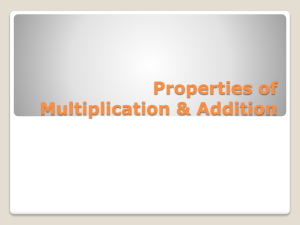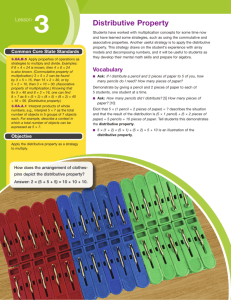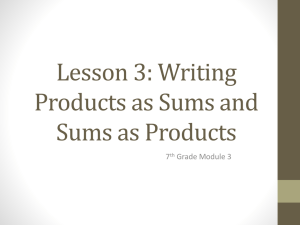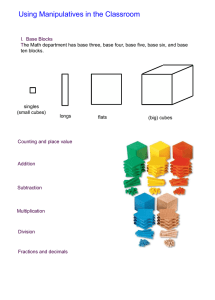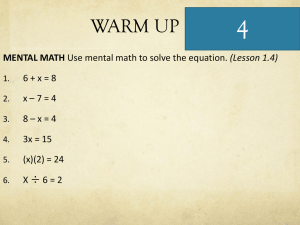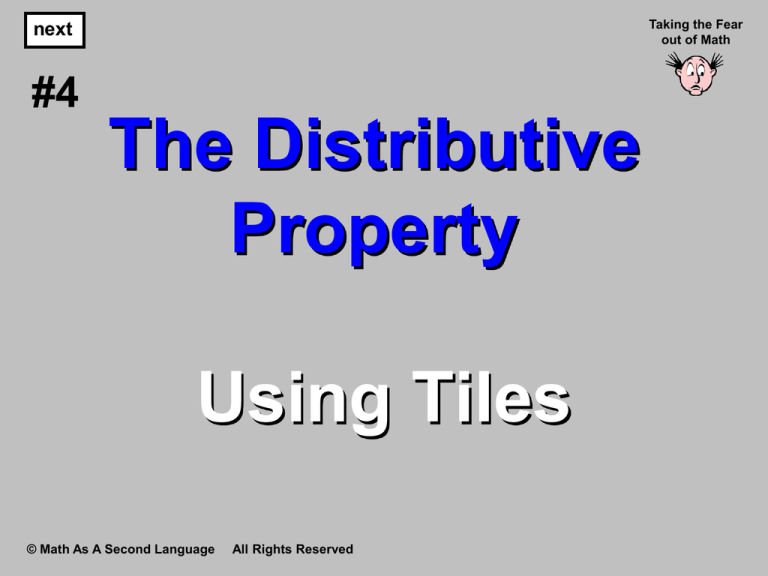
Taking the Fear
out of Math
next
#4
The Distributive
Property
Using Tiles
© Math As A Second Language
All Rights Reserved
next
In this and the following several
discussions, our underlying theme is…
Our Fundamental Principle of Counting
The number of objects in a set does not
depend on the order in which the objects
are counted nor in the form in which they
are arranged. For example, in each of the
six arrangements shown below, there are
3 tiles.
© Math As A Second Language
All Rights Reserved
next
In our previous three discussions we
used the above principle to demonstrate
the properties of closure, commutativity
and associativity.
Notice that in each of these discussions we
limited ourselves to the situations in which
either addition was the only operation or
multiplication was the only operation. That
is, we talked about such things as 2 + 3 + 5
and 2 x 3 x 5. However, we did not talk about
a computation in which both addition and
multiplication were involved.
© Math As A Second Language
All Rights Reserved
next
The property that links addition and
multiplication is known as the distributive
property or, more formally, as
“the distributive property of multiplication
over addition”.
Let’s introduce this new property by
discussing a “real life” situation.
© Math As A Second Language
All Rights Reserved
next
You are selling an item at a price of $6.
On the first day you sell 4 of these items
and on the second day you sell 5 more of
these items.
You want to determine how much money
you made by selling that item during those
two days.
© Math As A Second Language
All Rights Reserved
next
One way to determine how much
money you made each day is to add
the two daily results.
In other words, on the first day you
made (4 × 6) dollars.
On the second day you made (5 × 6)
dollars.
Thus, altogether for the two days, you
made (4 × 6) + (5 × 6) dollars.
© Math As A Second Language
All Rights Reserved
next
Another way to determine how much
money you made is to find the total
number of items you sold during the twoday sale and then multiply this number by
the price of each item that you sold.
In other words, since you sold 4 items
the first day and 5 items the second day,
the total number of items you sold during
these two days was (4 + 5), and at $6 per
item, you made (4 + 5) × 6 dollars.
© Math As A Second Language
All Rights Reserved
next
And since the two answers are the
same (namely, $54) it follows that…
(4 × 6) + (5 × 6) = (4 + 5) × 6
Since the numbers 4, 5, and 6 were used
only for illustrative purposes we can
generalize the above result by, for example,
replacing 4 by b, 5 by c, and 6 by a
to obtain the more general result…
(b × a) + (c × a) = (b + c) × a
© Math As A Second Language
All Rights Reserved
next
(b × a) + (c × a) = (b + c) × a
A more common form of the
distributive property is obtained by using
the commutative property 3 times:
Replace b × a by a × b, replace c × a by
a × c and replace (b + c) × a
by a × (b + c) to obtain…
(a × b) + (a × c) = a × (b + c)
© Math As A Second Language
All Rights Reserved
next
Finally, the above equality is usually written
by interchanging the right and left sides of
the equation to obtain the most general
form of the distributive property.
The Distributive Property
If a, b, and c are any whole numbers,
then
a × (b + c) = (a × b) + (a × c) .
© Math As A Second Language
All Rights Reserved
next
Notes
Because the times symbol looks like the
letter x it is conventional to replace the
notation a × b by either
ab, a • b, (ab), or a(b).
Thus, the above equality is usually
written as…
a(b + c) = (ab) + (ac)
© Math As A Second Language
All Rights Reserved
next
Notes
Another common agreement is that if there
is ambiguity when grouping symbols are
omitted, we perform all multiplications
before we perform any additions.
Thus, the above equality is often further
abbreviated as…
a(b + c) = ab + ac
© Math As A Second Language
All Rights Reserved
next
Special Note
Notice the importance of the grouping
symbols.
If we omitted them and wrote ab + c, the
agreement that we performed
multiplications before we performed
additions would have led to the equality
ab + c = (ab) + c
and
(ab) + c ≠ a(b + c).
© Math As A Second Language
All Rights Reserved
next
Special Note
To show that a(b + c) ≠ (ab) + c,
all we have to do is show one example
in which the equality is false.
If we let a = 6, b = 4 and c = 5,
we see that 6 ×(4 + 5) = 6 × 9 or 54,
but (6 × 4) + 5 = 24 + 5 or 29.
© Math As A Second Language
All Rights Reserved
next
Later in our course we will discuss
whole number multiplication
in greater detail.
For now, however, we wish to show how
our relatively simple introduction can be
a segue to more computationally
complicated applications of the
distributive property.
© Math As A Second Language
All Rights Reserved
next
By way of illustration, it is relatively easy
to “skip count” to conclude that 4 × 6 = 24.
That is, we count 6, 12, 18, 24, 30, 36, 42.1
However, it would be extremely
cumbersome to use “skip counting” to
compute, say 4 × 63.
This is where are adjective/noun theme
becomes very useful.
note
1 Skip
counting is a less technical way of listing the multiples of a number. For
example, when we are skip counting by 6's we are listing the multiples of 6.
In the language of multiples, the fact that 4 × 6 = 24 is stated as 24 is the 4th
multiple of 6 (and by the commutative properly it is also the 6th multiple of 4).
© Math As A Second Language
All Rights Reserved
next
Once we know that 4 × 6 = 24, we also
know that…
4 × 6 apples = 24 apples
4 × 6 dollars = 24 dollars
4 × 6 tens = 24 tens
© Math As A Second Language
All Rights Reserved
next
With this in mind we may think of 63
as being 6 tens + 3 (ones) and then
by the distributive property we see that…
4 × 63 =
4 × (6 tens + 3 ones) =
4 × 6 tens + 4 × 3 ones =
24 tens + 12 ones =
240 + 12 = 252.
© Math As A Second Language
All Rights Reserved
next
In terms of a real-life example, suppose
you sell 63 pens and make a profit of $4
on each pen you sell.
To find the total profit, you know
that if you sell 60 pens the profit is $240
and the 3 additional pens yield a $12 profit;
and hence your total profit is
$240 + $12 or $252.
© Math As A Second Language
All Rights Reserved
next
Tiles and the Distributive Property
While we do not have to use tiles to
demonstrate the distributive property, it
might be an easier way for younger
students to internalize the concept.
© Math As A Second Language
All Rights Reserved
next
Tiles and the Distributive Property
For example, to show that
2 × (3 + 4) = (2 × 3) + (2 × 4),
we could have the students look at 2 rows,
each with 7 tiles, as shown below.
In the above arrangement, we have 2 rows
each with (3 + 4) tiles; so the total number
of tiles is 2 × (3 + 4).
© Math As A Second Language
All Rights Reserved
next
Tiles and the Distributive Property
The number of tiles will remain the same if
we rearrange them as shown below.
In the above arrangement, we have one
group of tiles that consists of 2 rows,
each with 3 tiles (2 × 3 tiles) and another
group that consists of 2 rows, each with 4
tiles (2 × 4 tiles). So altogether there are
(2 × 3) + (2 × 4) tiles.
© Math As A Second Language
All Rights Reserved
next
Tiles and the Distributive Property
And since the number of tiles is the same
in each case…
…we see that
2
×
(3
+
4)
(2
×
3)
+
(2
×
4)
2 × (3 + 4) = (2 × 3) + (2 × 4).
© Math As A Second Language
All Rights Reserved
next
Associative
5(3 + 4)
5(3) + 5(4)
addition
multiplication
© Math As A Second Language
Hopefully, this snippet helps
you understand the power of
the distributive property and
our adjective/noun theme. In
any event this concludes our
discussion of the properties
of whole number arithmetic.
introduce them.
We will return to
this topic a bit later in our
course when there will be a
better motivation to
introduce them.
All Rights Reserved




